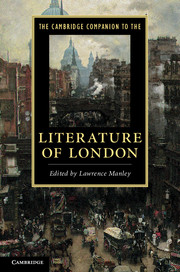Book contents
- Frontmatter
- Introduction
- 1 Images of London in medieval English literature
- 2 London and the early modern stage
- 3 London and the early modern book
- 4 London and poetry to 1750
- 5 Staging London in the Restoration and eighteenth century
- 6 London and narration in the long eighteenth century
- 7 London and nineteenth-century poetry
- 8 London in the Victorian novel
- 9 London in Victorian visual culture
- 10 London in poetry since 1900
- 11 London and modern prose, 1900-1950
- 12 Immigration and postwar London literature
- 13 Writing London in the twenty-first century
- 14 Inner London
- Guide to further reading
- Index
12 - Immigration and postwar London literature
Published online by Cambridge University Press: 28 September 2011
- Frontmatter
- Introduction
- 1 Images of London in medieval English literature
- 2 London and the early modern stage
- 3 London and the early modern book
- 4 London and poetry to 1750
- 5 Staging London in the Restoration and eighteenth century
- 6 London and narration in the long eighteenth century
- 7 London and nineteenth-century poetry
- 8 London in the Victorian novel
- 9 London in Victorian visual culture
- 10 London in poetry since 1900
- 11 London and modern prose, 1900-1950
- 12 Immigration and postwar London literature
- 13 Writing London in the twenty-first century
- 14 Inner London
- Guide to further reading
- Index
Summary
In an article published in the Guardian in 2004, the West Indian-born, British-raised novelist Caryl Phillips remarked on the curious absence in 1950s British literature of a phenomenon that was visibly transforming the nation throughout that decade. Immigration from the far-flung possessions of an empire that had begun decolonising in earnest after the war burgeoned in the 1950s, with the West Indies and Africa especially supplying hundreds of thousands of new residents to Britain (and to London in particular). Yet despite what Phillips calls 'the daily presence of these new people on the streets, on the buses, and working in hospitals and factories all over the country' at the time, leading British-born writers such as Kingsley Amis and John Osborne displayed a general - and perhaps, Phillips suggests, even a wilful - blindness to the nation's emerging multiracial and multicultural reality. The key exception, he notes, was Colin MacInnes, who was born in London in 1914, grew up in Australia, eventually moved back to London, and, in the late 1950s, wrote three important novels that feature multiracial groups of protagonists and vividly depict a city in flux. Of the three, Phillips gives pride of place to MacInnes's first, City of Spades, published in 1957.
- Type
- Chapter
- Information
- The Cambridge Companion to the Literature of London , pp. 222 - 240Publisher: Cambridge University PressPrint publication year: 2011
- 1
- Cited by

